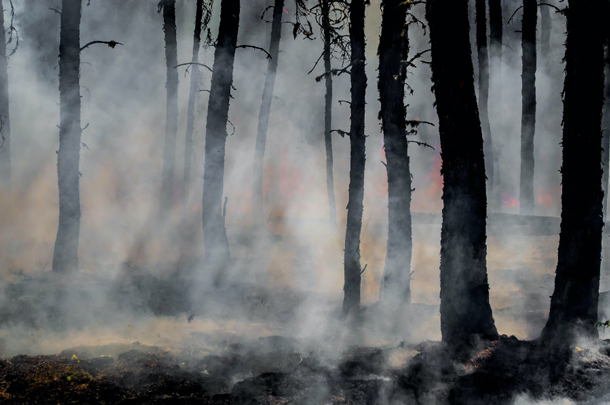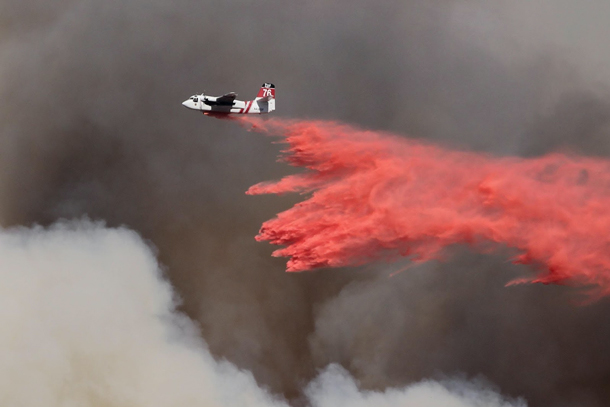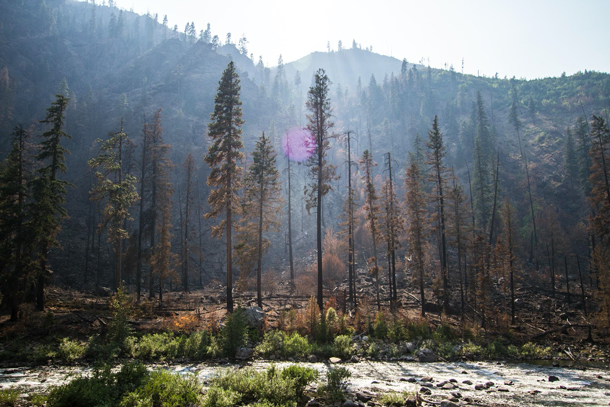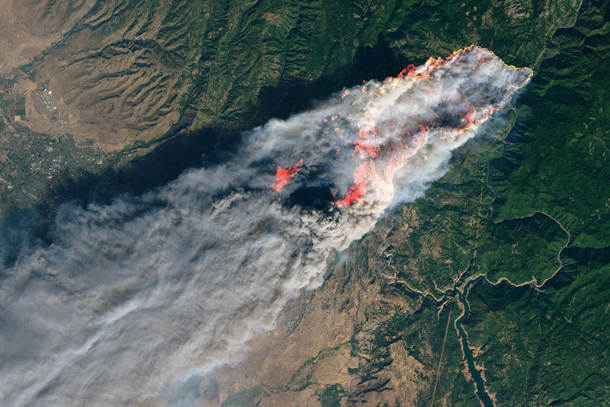How Wildfires Affect Water Quality
Air Date: Week of February 7, 2020

Debris from wildfires can flow downstream, carrying toxicants from nearby towns and cities (Photo: Joanne Francis, Unsplash)
As the Australian bushfires continue to rage, we take a look at how wildfires, and the methods we use to fight them, can seriously impact water quality downstream. Host Bobby Bascomb sat down with Newsha Ajami of the Stanford Woods Institute for the Environment to discuss the impacts of wildfires on water quality, and what can be done to mitigate the damage.
Transcript
BASCOMB: It’s Living on Earth, I’m Bobby Bascomb.
During a wildfire, like those still raging in parts of Australia, firefighters pray for rain to help them battle the blaze. And though rain brings relief it can also lead to a whole new set of problems for local waterways. For more, I’m joined by Newsha Ajami. She’s a hydrologist at Stanford University and sits on California’s regional water quality board.
Newsha, welcome to Living on Earth!
AJAMI: Thank you for having me.
BASCOMB: So, generally speaking, how does wildfire affect water in nearby rivers and streams and even lakes?
AJAMI: So, basically, wildfires change the landscape significantly, and they actually can create a deluge that eventually with the rain and the storm can end up in the water systems. Now, if the wildfire has an interface with urban areas, that becomes a lot more intense, and it will include more toxic materials from the burning of the chemicals, electronics, appliances, and a lot of other daily fixtures in our household. Also, smoke can eventually travel and go to different places and transport some of these chemicals through atmospheric processes. So, some of these impacts can go beyond the region that has been experiencing fire.
BASCOMB: And you talked a bit about urban areas and the things that could wash off into rivers there, but what about, you know, in a more wild area?
AJAMI: Yeah, so those are more natural materials that get burned, right? Trees, bushes. And it doesn't necessarily create chemical pollution in our water systems. However, it still can impact the waters by creating a smoke smell in the water or actually sediment that needs to be cleaned up. So, it's slightly different, but they both can impact the water quality.
BASCOMB: And what about the use of chemicals to put out fires? Those must also make their way into the water.

Fire suppressant chemicals such as Phos-Check fire retardant absorb oxygen, and when they wash into rivers following fires, can damage the oxygen balance of waterways. (Photo: Ben Kuo, Unsplash)
AJAMI: So yes, those fire retardants include some chemicals that are used to sort of suck oxygen out of fire and make sure it turns off, right? So it doesn't grow more. But those chemicals, actually, if it's washed off, it ends up in some of the water bodies in the close proximity to the fire area. It can have a lot of impact.
BASCOMB: Mmhmm. Now, I've read that some of the streams in Australia actually began to boil, if you can imagine that, during the fires there. That's of course, a really extreme case, but generally speaking, how are the wildlife in these areas impacted both during and after the fire?
AJAMI: They actually can be significantly impacted. We have to remember: they are the first receiver of some of these chemicals, and contaminants, and materials, and pollutants. And because of their body size, they are much more vulnerable to some of these chemicals and they can be significantly impacted. And also remember, water quality degradation is not just for the chemicals, also heat can be a water quality problem. And the freshwater ecosystem or marine ecosystem are very sensitive and vulnerable to some of these extreme changes in the temperature. Sometimes various regions have experienced big loss of these species due to some of these wildfires.

The aftermath of the 2014 Carlton Complex Wildfire from across the Okanogan River in northern Washington (Photo: Adam Cohn, Flickr, CC BY-NC-ND 2.0)
BASCOMB: Now, what kind of impact can wildfire have on drinking water in an area?
AJAMI: Depends on what kind of wildfire we're talking about. If the wildfires are happening in the rural area or in the forest area, or an area that's not necessarily interfacing with human urban areas, they can impact the amount of sediment in the water or the smell of the water. When we're talking about the urban areas, sort of being part of these fires, and if you have this whole, urban wildland interface being burned, then we can have some metals or other chemicals that we use in our daily lives ending up in the water that needs to be cleaned up and handled or managed differently.
BASCOMB: After a wild fire that burns hundreds or thousands of acres, how in the world can you clean that up?
AJAMI: So, for example, when we had the fire in Northern California a couple of years ago, the Army Corps of Engineers in collaboration with the Regional Water Board and a few other entities set up a coordinated effort, and they all went and cleaned up some of the sediment and sort of sandbagged some of the burnt areas. And that was very helpful to make sure some of these materials doesn't end up in the water systems. And one other thing I have to actually mention is these fires can also increase the possibility of erosion, especially when it's in the wildland. We experienced that in California in the Santa Barbara area because there was some fire that burned some of their wildland and urban areas. And then afterwards, we had an intense rainy season, which caused some landslides due to the loss of species that helped to keep the soils together. So that can also be one of the side effects of these fires.

After the November 2018 Camp Fire in Northern California, emergency response teams in Butte County relied on experts to evaluate wildfire impact and identify areas likely to experience flooding, debris, and mudslides (Photo: Stuart Rankin, Flickr, CC BY-NC 2.0))
BASCOMB: Now, you, of course, are an expert on California and the waterways there. But the world is looking to Australia right now as they battle with intense fires there. What are your thoughts on the Australia fire and how does that compare to what you've dealt with in California?
AJAMI: It is truly devastating and really worrisome, to be honest with you. I wonder if that's where we're looking at in a few years. Because right now, there have been chain of fires happening there. A lot of people have been impacted. A lot of wildlife have been impacted. And it's truly devastating. So far in California, our fire season has definitely been extended and has become longer and we have fires different times of the year now. And every year, we just hope that, you know, we can manage to make it through it. But, with Australia, right now their fire season haven't even started and the country is burning like this. So, God knows what's ahead of them.
BASCOMB: It's scary to think of. I mean, the thing is this problem with wildfires, it's not going to go away. As you mentioned, it's likely only to get worse. What do you think can really be done to mitigate the potential impacts on you know, specifically water that we're talking about here?

Newsha Ajami is Director of Water Policy at Stanford's Woods Institute and a member of the California Regional Water Quality Board (Photo: Stanford Woods Institute)
AJAMI: One point I'll make, we have to definitely reconsider how we are treating the water, how we are handling post-fire management. Actually, some of the most important work that we can do should be done pre-fire. So we are trying to manage land in a way that we can either reduce the intensity of some of these fires or prevent them from happening by doing forest management, wildland management, to make sure that we can reduce the intensity of these fires, or actually prevent them from happening. One might think, okay, the comments that I just made, this has nothing to do with water. But the reality is if we can't prevent these fires to happen, it can eventually impact our water bodies. That means that some of the water agencies and water utilities and different layers of local government and state government and federal government that are dealing with water and its accessibility should be considering to invest in the efforts to prevent or reduce intensity of some of these fires.
BASCOMB: Mmhmm.
AJAMI: I would say that's the cheapest and easiest way to get involved. Then we have to also consider how we need to change our treatment process or work with some of these groups that are on the ground to help us to clean up after the fire as fast as we can, deal with some of the post-fire sediments in a strategic way, that we don't impact our water bodies.
BASCOMB: Newsha Ajami is Director of Water Policy at Stanford's Woods Institute and she sits on the California Regional Water Quality Board. Newsha, thank you so much for taking this time with me.
AJAMI: Thank you for having me.
Links
Yale e360 | "How Wildfires Are Polluting Rivers and Threatening Water Supplies"
Living on Earth wants to hear from you!
Living on Earth
62 Calef Highway, Suite 212
Lee, NH 03861
Telephone: 617-287-4121
E-mail: comments@loe.org
Newsletter [Click here]
Donate to Living on Earth!
Living on Earth is an independent media program and relies entirely on contributions from listeners and institutions supporting public service. Please donate now to preserve an independent environmental voice.
NewsletterLiving on Earth offers a weekly delivery of the show's rundown to your mailbox. Sign up for our newsletter today!
 Sailors For The Sea: Be the change you want to sea.
Sailors For The Sea: Be the change you want to sea.
 The Grantham Foundation for the Protection of the Environment: Committed to protecting and improving the health of the global environment.
The Grantham Foundation for the Protection of the Environment: Committed to protecting and improving the health of the global environment.
 Contribute to Living on Earth and receive, as our gift to you, an archival print of one of Mark Seth Lender's extraordinary wildlife photographs. Follow the link to see Mark's current collection of photographs.
Contribute to Living on Earth and receive, as our gift to you, an archival print of one of Mark Seth Lender's extraordinary wildlife photographs. Follow the link to see Mark's current collection of photographs.
 Buy a signed copy of Mark Seth Lender's book Smeagull the Seagull & support Living on Earth
Buy a signed copy of Mark Seth Lender's book Smeagull the Seagull & support Living on Earth

